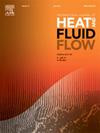Comprehensive review of heat transfer and fluid flow characteristics of elliptical/oval twisted tubes
IF 2.6
3区 工程技术
Q2 ENGINEERING, MECHANICAL
International Journal of Heat and Fluid Flow
Pub Date : 2024-12-24
DOI:10.1016/j.ijheatfluidflow.2024.109639
引用次数: 0
Abstract
Heat exchangers have long been widely used tools in various industries. The close association of heat exchangers with energy consumption motivates engineers to strive for high thermal efficiency through modifications in size and cost minimization in the design process. Active, passive, and compound techniques are employed to enhance heat transfer. Twisted tubes and inserts fall within the category of passive swirl flow devices. These devices enhance heat transfer by generating secondary flows and disrupting the thermal boundary layer. Twisted tubes have the potential to further augment heat transfer and improve the efficiency of heat exchangers by enlarging the surface area, mixing fluid flow, and amplifying turbulence. This review specifically focuses on twisted tubes with elliptical/oval cross-sections. Geometrical parameters such as twist pitch (number of twists) and cross-section characteristics significantly influence heat transfer enhancement in twisted tubes. In this review, studies that involve the combination of twisted elliptical/oval tubes with other passive techniques, such as inserts (wire coils, twisted tapes), and nanofluids, as well as active techniques, are also discussed. This work aims to contribute to enhancing heat exchanger performance through the application of the twisted tube technique.

求助全文
约1分钟内获得全文
求助全文
来源期刊

International Journal of Heat and Fluid Flow
工程技术-工程:机械
CiteScore
5.00
自引率
7.70%
发文量
131
审稿时长
33 days
期刊介绍:
The International Journal of Heat and Fluid Flow welcomes high-quality original contributions on experimental, computational, and physical aspects of convective heat transfer and fluid dynamics relevant to engineering or the environment, including multiphase and microscale flows.
Papers reporting the application of these disciplines to design and development, with emphasis on new technological fields, are also welcomed. Some of these new fields include microscale electronic and mechanical systems; medical and biological systems; and thermal and flow control in both the internal and external environment.
 求助内容:
求助内容: 应助结果提醒方式:
应助结果提醒方式:


